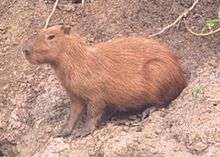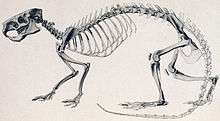Caviomorpha
Caviomorpha is the rodent infraorder or parvorder that unites all New World hystricognaths. It is supported by both fossil and molecular evidence. The Caviomorpha was for a time considered to be a separate order outside the Rodentia, but is now accepted as a genuine part of the rodents. Caviomorphs include the extinct Heptaxodontidae (giant hutias) and extant families of chinchilla rats, hutias, guinea pigs and the capybara, chinchillas and viscachas, tuco-tucos, agoutis, pacas, pacaranas, spiny rats, New World porcupines, coypu and octodonts (Vassallo and Antenucci, 2015).
| Caviomorpha | |
|---|---|
 | |
| Capybara | |
| Scientific classification | |
| Kingdom: | Animalia |
| Phylum: | Chordata |
| Class: | Mammalia |
| Order: | Rodentia |
| Infraorder: | Hystricognathi |
| Parvorder: | Caviomorpha Wood, 1955 |
| Families | |
|
see text | |
Origin

The first known rodent fossils in South America are represented by the three taxa Cachiyacuy contamanensis, C. kummeli, and Canaanimys maquiensis, as well as teeth from Eobranisamys sp. (Dasyproctidae) and Eospina sp., the latter two found also in the Santa Rosa fauna from the late Eocene or early Oligocene. By the late Oligocene, all superfamilies and most families of caviomorphs are present in the fossil record.
During this time, South America was isolated from all other continents. Several hypotheses have been proposed as to how hystricognath rodents colonized this island continent. Most require that a small group of these rodents traveled across ocean bodies atop a raft of mangroves or driftwood.
The most common hypothesis suggests that the ancestor to all modern caviomorphs rafted across the Atlantic Ocean (then narrower) from Africa (Lavocat, 1969; Huchon and Douzery, 2000). This is supported by molecular results, which suggest that the Phiomorpha (as restricted to Bathyergidae, Petromuridae, and Thryonomyidae) are sister taxa to the Caviomorpha. In fact, until the discovery of the Laotian rock rat, all modern hystricognath families were restricted to South America, Africa, or had a range that included Africa (Hystricidae).
The principal alternative hypothesis is that the caviomorph ancestor arose in Asia and migrated to South America through another continent. Most commonly, North America is cited as the most likely continent (Wood, 1985) as connections between North America and Asia were common via Beringia, and North America appears to have been closer to South America than any other continent at this time. The "Franimorpha" were once proposed as a potential North American rodent group that may represent an ancestor to the Caviomorpha, but most modern researchers consider franimorphs to have been protrogomorphous instead of hystricomorphous.
Fossil evidence suggests the Entodacrya may have originated in Asia (Marivaux et al., 2004) and this is cited as potential evidence for an Asian origin for Caviomorpha as well. Likewise, Jenkins et al. (2005) argue that their discovery of a hystricognath rodent family (Laonastidae) exclusive to Asia may be further evidence for an Asian origin of caviomorphs.
Alternatively, the caviomorphs may have originated in Asia, but traveled through Africa, Australia and Antarctica, or Africa and Antarctica (noted but not advocated by Huchon and Douzery, 2001). Alternatively they may have originated in Africa and traveled to South America via Antarctica.
New World monkeys appear to have colonized South America from Africa at a similar time.
Caviomorphs went on to colonize the West Indies as far as the Bahamas, reaching the Greater Antilles by the early Oligocene.[1] This is commonly viewed as another example of oceanic dispersal,[2][3] although a role for a possible land bridge has also been considered.[1]
Diversity
Caviomorph rodents underwent an explosive diversification upon arrival into South America. They managed to outcompete other animals in rodent-like niches such as certain South American marsupials. Retaining predominantly herbivorous diets, they expanded their sizes to encompass a range from rat-sized echimyids to the bison-sized Phoberomys. Their ecologies included burrowing gopher-like forms such as tuco-tucos, arboreal forms such as porcupines and certain spiny rats, running forms such as maras, and aquatic forms such as the capybara and nutria (Vassallo and Antenucci, 2015). Habitats range from grasslands (maras), high mountains (chinchillas and chinchilla rats), forest edges (prehensile-tailed porcupines) and dense tropical forests (pacas and acouchis).
Although many species of caviomorphs have migrated into Central America since the Great American Interchange, only a single living species, the North American porcupine, has naturally colonized North America north of Mexico (the extinct capybara Neochoerus pinckneyi also accomplished this feat). The nutria has been introduced into North America and has proven a highly successful invasive species there.
Families
- Parvorder Caviomorpha - New World hystricognaths
- †Luribayomys - incertae sedis
- Superfamily Erethizontoidea
- Family Erethizontidae - New World porcupines
- Superfamily Cavioidea
- †Guiomys
- †Scotamys
- Dasyproctidae - agoutis and acouchis
- Cuniculidae - pacas
- †Eocardiidae
- Dinomyidae - pacarana
- Caviidae - cavies, capybaras, and maras
- Superfamily Octodontoidea
- †Caviocricetus - incertae sedis
- †Dicolpomys - incertae sedis
- †Morenella - incertae sedis
- †Plateomys - incertae sedis
- †Tainotherium Turvey, Grady & Rye, 2006 - incertae sedis
- Octodontidae - degus and relatives
- Ctenomyidae - tuco-tucos
- Echimyidae - spiny rats
- Myocastoridae - coypus (nutria)
- Capromyidae - hutias
- †Heptaxodontidae - giant hutias (probably paraphyletic)
- Superfamily Chinchilloidea
- †Borikenomys - incertae sedis
- †Maquiamys - incertae sedis
- †Tsaphanomys - incertae sedis
- Chinchillidae - chinchillas and viscachas
- †Neoepiblemidae
- Abrocomidae - chinchilla rats
Note that some changes to this taxonomy have been suggested by molecular studies. The Dinomyidae may belong to the Chinchilloidea, the Abrocomidae may belong to the Octodontoidea, and the Hydrochaeridae may have evolved from within the Caviidae.
References
Citations
- Vélez-Juarbe, J.; Martin, T.; Macphee, R. D. E.; Ortega-Ariza, D. (January 2014). "The earliest Caribbean rodents: Oligocene caviomorphs from Puerto Rico". Journal of Vertebrate Paleontology. 34 (1): 157–163. doi:10.1080/02724634.2013.789039.
- Hedges, S. Blair (November 1996). "Historical biogeography of West Indian vertebrates". Annual Review of Ecology and Systematics. 27 (1): 163–196. doi:10.1146/annurev.ecolsys.27.1.163.
- Hedges, S. Blair (2006-08-23). "Paleogrography of the Antilles and Origin of West Indian Terrestrial Vertebrates". Annals of the Missouri Botanical Garden. 93 (2): 231–244. doi:10.3417/0026-6493(2006)93[231:POTAAO]2.0.CO;2.
Sources
- Huchon, D. E. J. P. Douzery. 2001. "From the Old World to the New World: A molecular chronicle of the phylogeny and biogeography of hystricognath rodents". Molecular Phylogenetics and Evolution, 20:238-251.
- Jenkins, P. D., C. W. Kilpatrick, M. F. Robinson, and R. J. Timmins. 2004. "Morphological and molecular investigations of a new family, genus and species of rodent (Mammalia: Rodentia: Hystricognatha) from Lao PDR". Systematics and Biodiversity, 2:419-454.
- Lavocat, R. 1969. "La systématique des rongeurs hystricomorphes et la dérive des continents". C. R. Acad. Sci. Paris Sér. D., 269:1496-1497.
- Marivaux, L. M. Vianey-Liaud, and J.-J. Jaeger. 2004. "High-level phylogeny of early Tertiary rodents: dental evidence". Zoological Journal of the Linnean Society, 142:105-134.
- McKenna, Malcolm C., and Bell, Susan K. 1997. Classification of Mammals Above the Species Level. Columbia University Press, New York, 631 pp. ISBN 0-231-11013-8
- Opazo, J. C. 2005. A molecular timescale for Caviomorph rodents (Mammalia, Hystricognathi). "Molecular Phylogenetics and Evolution", 37:932-937.
- Vassallo, A. I., and C. D. Antenucci. 2015. Biology of Caviomorph Rodents: Diversity and Evolution. Sociedad Argentina para el Estudio de los Mamíferos (SAREM) Series A Mammalogical Research.
- Wood, A. E. 1985. The relationships, origin, and dispersal of hystricognath rodents. pp 475–513 in Evolutionary relationships among rodents, a multidisciplinary approach (W. P. Luckett and J.-R. Hartenberger, eds.). Plenum Press, New York.